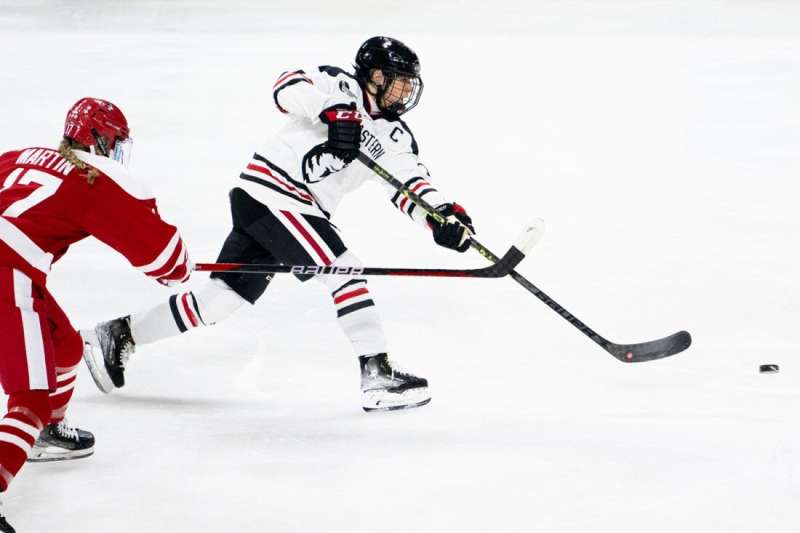This article has been reviewed according to Science X's editorial process and policies. Editors have highlighted the following attributes while ensuring the content's credibility:
fact-checked
trusted source
proofread
Physicist discusses the forces responsible for a good hockey slap shot

Hockey fans everywhere love a good slap shot. It is one of the most widely used tools in the game, responsible for some of the sport's most memorable moments.
It's a skill perfected by all the top goal-scorers, including Northeastern's Aidan McDonough and Alina Mueller, who lead their teams into their respective Beanpot finals.
To the casual observer the slap shot looks pretty simple: A player raises his or her stick waist or shoulder high, then violently "slaps" the puck with as much force as possible.
But the slap shot is more than just a test of strength. It's also a technical maneuver that depends on multiple factors, including the hockey stick's "flex," its material composition, and the player's size and position on the ice.
Underlying our collective appreciation of sport is an appreciation of the physical laws at work during our favorite sporting moments. What physical forces make the fabled slap shot the spectacle that it is? We asked one of our own physicists to demystify the maneuver.
When you drill down into it, the slap shot involves fairly basic physics, says Arun Bansil, university distinguished professor of physics at Northeastern.
"All of what we see going on can be thought of in a coherent way—as simply energy moving from one form to another," he says.
It's useful to think of energy in two forms: potential energy and kinetic energy. Potential energy is energy that is stored or bound up in an object relative to its position to other surrounding objects. Here, a hockey player's body and their hockey stick contain potential energy.
Kinetic energy is the energy an object possesses due to its motion. In other words, it's the energy transferred from a player's body and stick when they go to strike the puck.
"The slap shot is converting one form of energy into kinetic energy," Bansil says.
The hallmark of an effective slap shot is a player's ability to get the puck to travel across, or above, the ice at a high rate of speed. How else are they supposed to get past the opposing team's goalie, if not with sheer velocity?
But to do that, they use the energy generated in bending the hockey stick, which works to convert that potential (stored) energy into the kinetic energy of the puck, Bansil says.
"If the stick can be bent a lot, that will allow the player to impart more kinetic energy to the puck," Bansil says, "The type of material makes a difference, too."
That bend, or flex, is part of a wholly separate scientific enterprise within the sport: stick selection. Hockey sticks come with different specs that favor players of certain size and ability.
A hockey stick's flex is determined by measuring the pressure exerted on the stick for every inch it bends. A 100 flex hockey stick, for example, would take 100 pounds of pressure to bend the stick one inch.
When executing the slap shot, the player must exploit all of these physical phenomena to get the ball to travel. Beginning with the backswing, the skater takes his or her stick back to an upright or parallel position; the player then drives the stick down toward the puck in a swinging motion, making contact with the ice beforehand to generate more flex. This process initiates the above-mentioned energy transfer.
The speed at which the player sends the puck hurtling toward the goal again depends on how much energy the player has stored prior to contact.
"That energy comes from the bending of the stick, but it also comes from the motion of the player itself," Bansil says. "If the player is skating a fast speed and he's able, through his muscles, to give some additional speed to the hockey stick, and the puck happens to be moving already in that direction toward the goal—all of that will end up helping the skater by further enhancing the puck's speed on contact," Bansil says.
These fundamental physical principles extend well beyond the game of hockey, too—a fact many of us spectators occasionally take for granted.
"Whether it's a tennis racquet or a baseball bat or a golf club, it's all the same underlying physics. That is, you're trying to convert energy from other forms—mainly elastic—and transfer it into the object you want speed from, " Bansil says.
Provided by Northeastern University



















